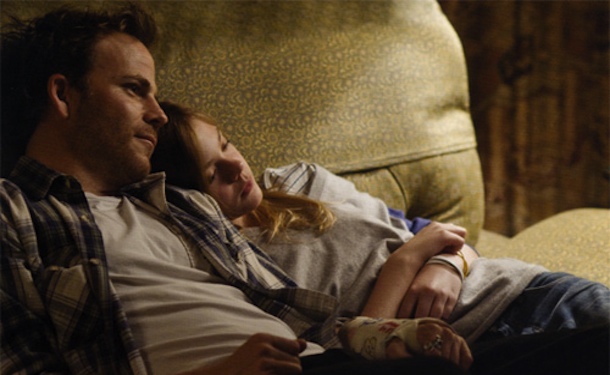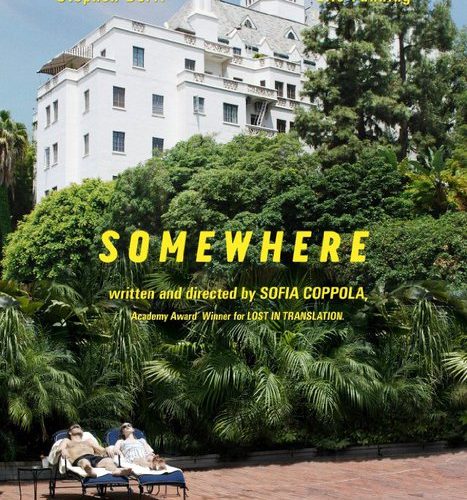
Though it be writer/director Sofia Coppola‘s fourth film, Somewhere feels like her first. It’s the kind of flawed, precious and passionate character study, both helped and hindered by a wide film school-knowledge of cinema, that proudly introduces a new filmmaker to the masses. Unfortunately, we’ve known Coppola for some time now.
Once indie-prince Stephen Dorff stars as action movie star Johnny Marco, drinking and sleeping through life in the Chateau Marmont Hotel in Los Angeles. The first shot of the film lasts 3 minutes and consists of Johnny doing laps around a race track in a fancy car. And so goes the rest of the film, mostly nowhere. Until it goes places, and then it’s over.
Johnny’s daughter Cleo (the lovely Elle Fanning) shows up for some “dad” time early on and then leaves for a good while. During this time Johnny returns to his Camel Lights and loose women. He gets snarked at by another disappointed co-star (Michelle Monaghan) right before he’s asked “Who is Johnny Marco?” at a press conference for his new film. It should be noted that this is all done in one, impressive shot, courtesy of the uber-talented Harris Savides.
There are plenty of interesting shots and plenty of interesting scenes in between a considerable amount of not too much. One standout sequence starts at a red light. A pretty girl in a convertible pulls up next to Johnny, and the two make eye contact. The light turns green and all of a sudden Johnny’s following this girl. She doesn’t seem to be in on the joke and pulls into what is presumably her driveway. What was Johnny expecting to happen? A late afternoon convertible tryst? Was he just curious? There aren’t enough moments like this.
Mostly we watch Johnny. We watch him watch dancers go through two separate routines from start to finish on their portable stripper poles in his hotel room within 15 minutes of each other. We watch him shower with his cast on (he breaks his arm in the first few minutes). We watch him light a dozen cigarettes and put his sunglasses on or off half a dozen times. These things are meant to be redundant and are exactly that.
To this end Coppola should be commended. Making an unblinking film about a rich actor who does nothing all day can be about as polarizing as making an unblinking film about, say, a Queen who does nothing all day. And much like Kirsten Dunst in Marie Antoinette, Dorff is more-than-capable softly collapsing from some combination of expectation, failure and boredom. Minutes tick by and his face barely flinches. Then, when it does move, it is genuinely moving. Consider a scene in which the beautiful woman Johnny’s slept with the night before decides to stay for some morning coffee, while Johnny’s 11-year-old Cleo sits right there. Cleo’s not happy about it and wants her father’s to recognize her frustration. So she burrows her brow and rolls her eyes at him. He fiddles with the coffee and tries to make small talk, then finally looks up at his girl. His face gets long and his eyes grow wide, the closest thing Cleo’s going to get to an apology. Even when Johnny does apologize, later on, Cleo hears nothing, the sound obstructed by the loud helicopter in the background, waiting to take the actor away.
Fanning, younger sister of Dakota, has a natural grace to her most movie stars pray for. Whatever acting she does here feels completely unintentional. Rarely does somebody appear to try so little to create what becomes such a tragic, relatable character. Her screen time is surprisingly limited despite being the entire plot of the film. Her second, surprise visit is complimented by a call from her mother, telling Johnny she’s going away for a while. We feel the weight of this broken family on Cleo’s shoulders without ever having to be told as much. And when we are told as much, it’s devastating.
It’s not as funny as Lost In Translation or as BIG as Marie Antoinette, but remains a film to marinate and consider and ponder.
Have you seen Somewhere? What do you think of Coppola’s body of work?


